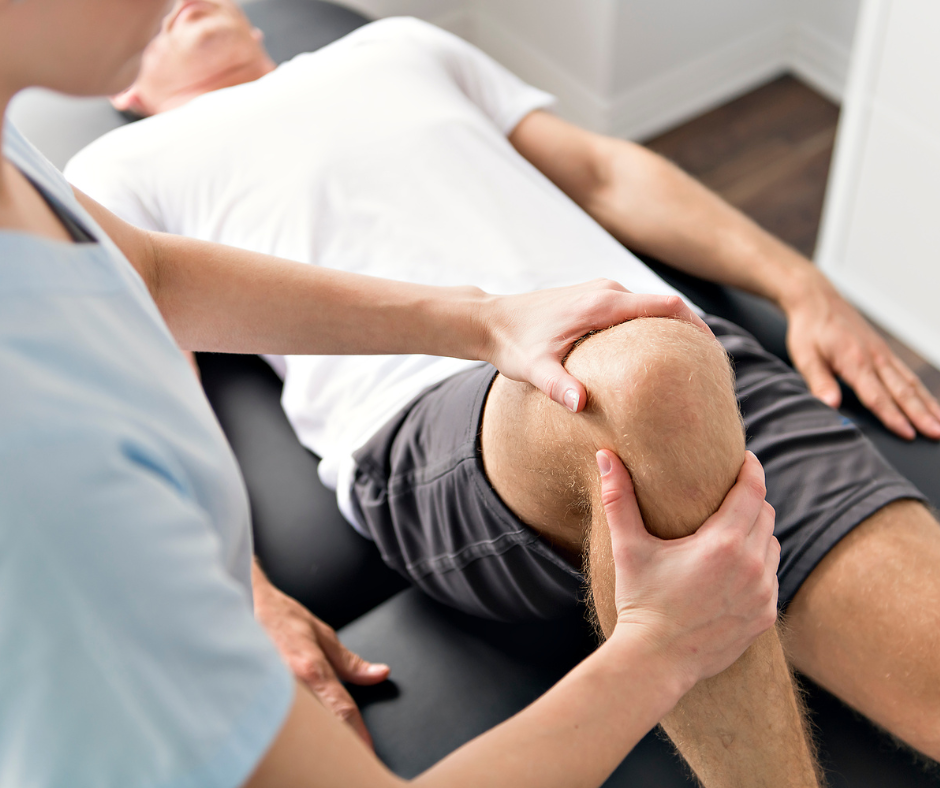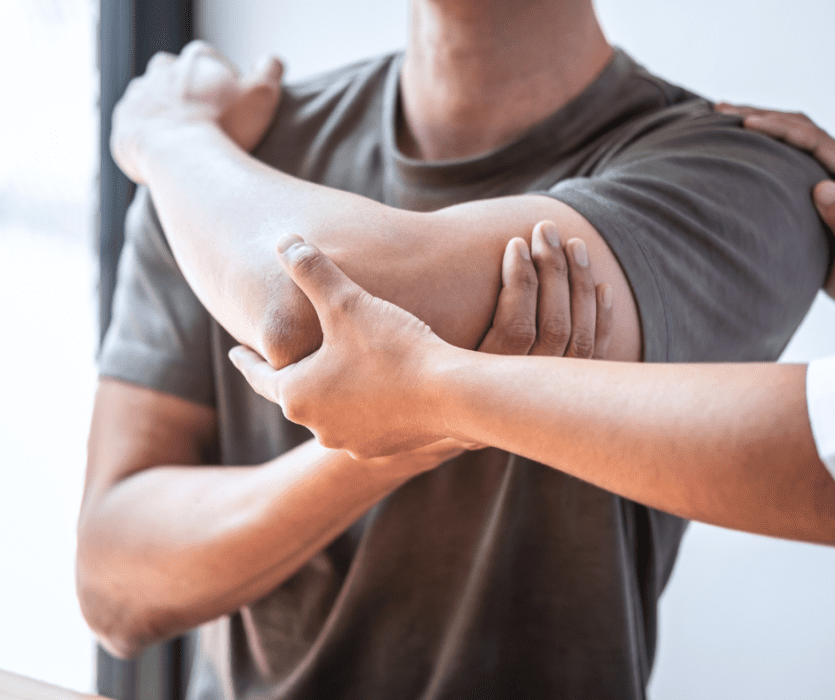Physiotherapy Tips on How to Fix Posture
With an increasing number of people working from home these days, understanding and maintaining good posture is more crucial than ever. Extended periods sitting at makeshift workstations can significantly impact good posture. But good posture isn’t just about how you sit; it’s a vital component of your physical and mental well-being. In this article we will discuss how to fix posture by incorporating physiotherapy exercises and posture stretches that can be adapted to your daily life. These exercises and stretches will not only help improve posture, but also enhance overall well-being and productivity.
The Importance of Good Posture
Good posture is essential not only for physical health but also for mental well-being. It enhances lung capacity, improves circulation, supports the spine, and can even influence mood and energy levels. For those working from home, maintaining good posture is vital to prevent the onset of musculoskeletal disorders which can develop from poor ergonomic practices.
The Foundation of Good Posture
Posture is more than just how you sit or stand. It encompasses how you carry yourself during various activities, whether you’re at work, home, or play. The first step to improving posture is recognizing poor habits. Common signs of bad posture include slouching, hunching over your desk, or tilting your head while using your phone .
Exercises and Stretches to Improve Posture
Incorporating specific physiotherapy exercises and posture stretches can significantly enhance posture:
- Shoulder Blade Squeeze: This exercise is ideal for rectifying slouched shoulders, a common issue among desk workers. Sit up straight in your chair, pull your shoulders back, squeezing the shoulder blades together. Hold for 10 seconds and release. Repeat several times a day to strengthen your upper back muscles, vital for good posture.
- Chin Tucks: To reduce neck strain, a common ailment when looking down at a laptop, perform chin tucks. Pull your chin straight back, creating a “double chin,” to stretch the neck muscles. Hold for 5 seconds and release. Repeat 10 times.
- Hip Flexor Stretch: Long sitting hours can tighten hip flexors, contributing to lower back pain. Perform this stretch by kneeling on one leg, with the other foot in front, and pushing your hips forward until you feel a stretch in the thigh of the back leg.
- Cat-Cow Stretch: A well-known yoga and physiotherapy exercise that improves spine flexibility. Alternate between arching your back towards the ceiling (Cat) and dipping it towards the floor (Cow) to maintain a supple and supportive spine.

Ergonomic Adjustments for Better Posture
In addition to exercises, making ergonomic adjustments is crucial, especially if you spend long hours at a desk. Consider making the following to help improve your posture:
- Chair and Desk: Invest in a quality chair that supports the spinal curves. Ensure that the desk height allows your arms to form a 90-degree angle at the elbows while typing.
- Monitor Height: Position your screen so the top of the monitor is at or just below eye level to avoid tilting your head forward, which puts strain on your neck.
- Peripheral Placement: Keep the keyboard and mouse within easy reach to avoid overextending or straining your arms.
The Role of Regular Movement
Changing positions frequently is crucial. Consider using standing desks or convertible workstations to alternate between sitting and standing. Regular breaks for stretching, changing your position and walking around also help mitigate risks associated with prolonged sitting. This prevents muscle fatigue and encourages circulation, reducing the risk of posture-related discomfort.
Incorporating these physiotherapy tips and posture exercises into your daily routine can drastically improve the quality of your work life, especially when working from home. Taking proactive steps to fix and improve your posture can lead to significant health benefits and a more productive, happier lifestyle.
FAQs for Physiotherapy Tips on How to Fix Posture
- How often should I take breaks from sitting?
Ideally, take a short break every 30 minutes to stand, stretch, or walk briefly. - Can poor posture affect mental health?
Yes, poor posture can lead to decreased energy levels and increased feelings of depression due to less effective breathing and reduced oxygen levels. - What are simple posture exercises I can do at my desk?
Aside from the shoulder blade squeeze and chin tucks, consider simple head movements and neck stretches to keep your upper body loose. - How long does it take to correct poor posture?
Improvement can be seen in a few weeks to months, depending on consistency in practicing exercises and maintaining good ergonomics. - What are the signs that I need to see a physiotherapist for my posture?
If you experience persistent pain, discomfort, or other physical issues like numbness or tingling, it’s wise to consult a physiotherapist. You can book a physiotherapy appointment and we can support you.
How many types of Physiotherapy Treatment are there?
Physiotherapy offers a spectrum of treatments targeting different age groups, health conditions, and specific physical requirements. This article explores the various types of physiotherapy treatment, each playing a unique role in promoting health, facilitating recovery, and enhancing quality of life. Understanding the different types of physiotherapy treatments available can help patients make informed choices about their care.
Key Takeaways :
- Different Types of Physiotherapy: Covers the range of types of physiotherapy treatment, highlighting their unique applications.
- Condition-Specific Approaches: Explores how different types of physiotherapy, such as orthopedic, neurological, and sports physiotherapy, are uniquely suited to specific health challenges.
- Impact on Health and Wellness: Illustrates the significant role of physiotherapy in promoting health, aiding recovery, and enhancing life quality across different populations.
So, How Many Types of Physiotherapy Treatments Are There?
In this article, we will be discussing eight various physiotherapy treatment types. Each type offers a distinct approach and methodology, addressing varied and specific needs of patients. As we move into a detailed exploration of physiotherapy’s branches, these key points will guide our understanding of the distinct roles of different types of physiotherapists in enhancing health and quality of life.
Pediatric Physiotherapy
Focusing on the youngest in our society, pediatric physiotherapy, a specific type of physiotherapy treatment, addresses a wide range of childhood conditions. From developmental delays to sports injuries, pediatric physiotherapists, a distinct type of physiotherapists, employ playful, engaging techniques to help children overcome physical challenges. Early intervention in conditions like cerebral palsy or developmental coordination disorder can significantly alter a child’s health trajectory, emphasizing the crucial role of this specialty.
Geriatric Physiotherapy
Geriatric physiotherapy caters to the elderly, a demographic often grappling with age-related conditions such as arthritis, osteoporosis, and balance disorders. Gentle exercises, pain management strategies, and tailored programs are designed to enhance mobility and independence, significantly impacting the life quality of older adults. This type of physiotherapy treatment is crucial for maintaining seniors’ health and well-being.
Orthopedic Physiotherapy
Orthopedic physiotherapy, another vital type of physiotherapy treatment, focuses on the musculoskeletal system, dealing with injuries and conditions like fractures, sprains, and post-operative recovery. Through personalized rehabilitation programs, patients are guided towards regaining strength and function, often expediting their return to daily activities and improving their overall well-being.
Cardiopulmonary Physiotherapy
Cardiopulmonary physiotherapy, a specialized branch of physiotherapy treatment types, is dedicated to heart and lung health, providing essential care for conditions such as chronic obstructive pulmonary disease (COPD) and recovery after heart attacks. Techniques like breathing exercises and endurance training aim to boost cardiopulmonary function, enhancing patients’ overall health and resilience.
Neurological Physiotherapy
Neurological physiotherapy, or neurological rehabilitation, offers a ray of hope to those suffering from disorders like stroke, multiple sclerosis, and Parkinson’s disease. Therapists in this field use specialized techniques to enhance movement, balance, and coordination, playing a pivotal role in improving the daily lives of patients with neurological conditions. This type of physiotherapy treatment is tailored to address complex neurological issues.

Sports Physiotherapy
Sports physiotherapy benefits athletes across the spectrum, from those who exercise to professionals. This branch focuses on preventing and rehabilitating sports injuries, helping athletes maintain peak performance. Treatments often include muscle conditioning and joint mobilization, crucial for swift and effective recovery. Sports physiotherapy is a critical type of physiotherapy treatment for athletic individuals.
Women’s Health Physiotherapy
Addressing the unique physical needs of women, this specialty covers conditions ranging from pregnancy-related issues to pelvic floor disorders. Customized treatments and exercises empower women to manage and surmount these challenges, fostering better overall health and wellness. Women’s health physiotherapy is a distinct type of physiotherapy treatment focusing on female-specific health concerns.
Vestibular Physiotherapy
Vestibular physiotherapy specializes in managing balance and dizziness disorders, conditions that can be debilitating and disorienting. Rehabilitation techniques in this field are vital for improving the quality of life for individuals suffering from vestibular issues, helping them regain stability and confidence in their daily activities.
Conclusion
The field of physiotherapy is vast and varied, with each specialty offering targeted interventions to meet specific health needs. From aiding the youngest to supporting the oldest, from enhancing sports performance to managing chronic conditions, the different types of physiotherapy treatment play an indispensable role in healthcare.
Selecting the appropriate type of physiotherapy depends on each individual’s specific condition and needs. Consulting with qualified physiotherapists is crucial in making an informed decision. If you are looking for physiotherapy but are unsure of which type of physiotherapy treatment would benefit your needs, contact us and we can help guide you.
FAQs
- How does pediatric physiotherapy differ from adult physiotherapy?
Pediatric physiotherapy is tailored to the unique developmental needs and conditions of children, using age-appropriate techniques and interventions.
- Can geriatric physiotherapy help in preventing falls in the elderly?
Yes, through balance training and muscle strengthening, geriatric physiotherapy plays a key role in fall prevention among older adults.
- What types of conditions does orthopedic physiotherapy treat?
Orthopedic physiotherapy treats a range of musculoskeletal conditions, including injuries, post-surgery recovery, and chronic pain issues.
- Is cardiopulmonary physiotherapy beneficial for long-term heart disease management?
Absolutely, cardiopulmonary physiotherapy is crucial in managing chronic heart conditions, improving cardiac function, and enhancing patients’ quality of life.
- How does neurological physiotherapy assist stroke patients?
It helps stroke patients by retraining their bodies to regain movement and coordination, often significantly improving their ability to perform daily tasks.
- What role does sports physiotherapy play in injury prevention?
Sports physiotherapy focuses on conditioning and strengthening specific muscle groups, significantly reducing the risk of sports-related injuries.
Preventing Winter Injuries: Physiotherapy Tips for Snow Shoveling Safety
As the winter season sets in and the ground begins to be covered with snow, the task of snow shoveling becomes a regular activity. While it’s a necessary chore, without proper techniques and preparation, it can lead to back pain after shoveling, forearm pain after shoveling, and other injuries.
Understanding and applying physiotherapy tips can significantly reduce the risk of these winter-related and snow shoveling strains and injuries. This article provides physiotherapy advice and techniques on how to shovel snow safely, aiming to prevent common winter injuries like back and shoulder strain.
Prepare for Snow Shoveling Safety
Have a preventive plan
Snow shoveling is not just a chore; it’s a physical activity that requires preparation. Start by assessing the area you need to shovel. Plan to remove snow in stages, especially if there’s a heavy accumulation. This approach reduces the physical demand and the risk of muscle strain.
Planning your approach to snow shoveling can significantly reduce physical strain. Assess the area and decide on the sequence of clearing snow, focusing on critical places first.
Choose the Right Snow Shovel and Tools
The choice of shovel can make a significant difference. A lightweight shovel with a curved handle can help reduce the bending required, thereby protecting your back. Also, consider a shovel with an adjustable handle length to match your height.
Pusher or Wide Shovel
Selecting the appropriate shovel is crucial. A lightweight, ergonomic shovel can reduce back strain. Consider the type of shovel based on your needs: a pusher or a wide shovel can be more efficient for different snow types.
A pusher shovel is ideal for clearing light, fluffy snow, while a wide shovel is better for heavy snow. Choose the one that suits the snow conditions in your area.
Dress in layers for warmth and flexibility. Dress in breathable, water-resistant layers to maintain body warmth without overheating.
Wear sturdy, slip-resistant boots to prevent falls, especially when dealing with ice. Good quality gloves can prevent forearm pain by offering support and reducing the strain on your hands and wrists.
Warm Up and Prepare Yourself
A 10-minute warm-up that includes stretching and light cardio exercises can prepare your muscles for the physical activity ahead. Focus on stretches that target your back, arms, and legs.
Mentally and physically prepare for the task. Understand your limits and don’t push beyond what your body can handle.
Drink plenty of water
Stay hydrated by drinking water before, during, and after shoveling. This helps prevent muscle cramps and fatigue.
Techniques on How to Shovel Snow Safely
Use Proper Body Mechanics
When shoveling, bend your knees and keep your back straight. Lift with your legs, not your back. Avoid twisting your torso; instead, move your feet to turn your body.
Whenever possible, push the snow to the side instead of lifting it. This technique reduces the load on your back and shoulders.
Know when to start and quit
Timing is crucial. Begin shoveling when the snow is fresh and lighter. Take breaks every 20-30 minutes, and hydrate regularly. If you feel any pain, especially in the back or chest, stop immediately.
Shovel small amounts
It’s better to shovel smaller amounts of snow more frequently than to move large piles at once. This reduces the strain on your body and is particularly important in preventing back pain after shoveling.
Pace yourself
Shoveling snow is a strenuous activity. Maintain a steady pace and take frequent breaks. This is crucial in preventing exhaustion and injuries.
Watch Out for Ice
Be vigilant for icy patches hidden under the snow. Clear these areas carefully to prevent slips and falls.
Clear Critical Places
Prioritize clearing paths to doorways, driveways, and sidewalks. Ensure these areas are accessible for safety and convenience.
Clear High Snow and Drifts
Tackle high snow and drifts by breaking them down into manageable layers. Avoid overreaching or overexerting yourself.
Add Ice Melt on Stubborn Ice
For areas where ice is thick or difficult to remove, use ice melt products to break it down before shoveling.
Add Ice Melt on Clear Areas
After shoveling, apply ice melt on clear areas to prevent ice formation, especially on walkways and steps.
Prepare for Additional Snow Shoveling
Be ready for more snowfall. Keep your tools accessible and maintain a routine to manage snow efficiently throughout the season.
Post-Shoveling Care
Cool down
After shoveling, perform gentle stretching exercises to relax your muscles. This helps in reducing muscle soreness and stiffness.
Hydrate and rest
Drink plenty of fluids to rehydrate your body. If you feel sore, apply a cold pack to the affected area for 15-20 minutes to reduce inflammation.
Seek physiotherapy if needed
If you have persistent pain or discomfort after shoveling, consider scheduling a physiotherapy session. Ignoring pain can lead to serious injuries. Early intervention can prevent long-term issues. A physiotherapist can provide targeted treatments and exercises to alleviate pain and prevent future injuries.
Snow shoveling, while a necessary winter chore, should be approached with care to avoid injuries. By incorporating these physiotherapy tips, you can shovel snow safely and efficiently, minimizing the risk of winter injuries. Remember, your health and safety are paramount. If you experience any pain or discomfort, it’s important to seek professional advice. For personalized guidance and care, don’t hesitate to book an appointment with a physiotherapist.
FAQs
- Is it necessary to warm up before snow shoveling? Yes, warming up prepares your muscles and reduces the risk of injuries.
- What are the common injuries associated with snow shoveling? Common injuries include muscle strains, particularly in the lower back, shoulder pain, and injuries due to slips and falls.
- How can physiotherapy help in preventing winter injuries while shoveling snow? Physiotherapy offers techniques for proper body mechanics, muscle strengthening, and tailored exercises to prevent injuries.
- What should I do if I experience pain or strain while snow shoveling? Stop immediately, rest, and apply cold packs if necessary. If pain persists, consult a healthcare professional or a physical therapist.
Discover Physiotherapy Exercises for Lower Back Pain
Are you tired of dealing with chronic lower back pain?
In this guide, we’re going to go through some of the best physiotherapy exercises that target lower back pain. You will also learn more about our favourite exercise, which we think is the single best exercise for lower back pain relief, the pelvic tilt.
You’ll discover:
- The science behind why specific exercises work wonders for your lower back.
- Step-by-step instructions to perform chronic lower back pain exercises correctly for maximum benefit.
- Tips to integrate the single best exercise for lower back pain seamlessly into your daily routine.
If you’re battling with lower back pain, you’re not alone. This condition affects a large number of people, especially in the new work from home era where many of us spend prolonged hours seated.
Lower back pain is often the outcome of several factors such as poor posture, inadequate muscle strength, limited flexibility, or injury. The right exercises can tackle these issues by strengthening crucial muscle groups, enhancing flexibility, and bolstering core stability. This not only provides pain relief but also aids in preventing future injuries.
Engaging in regular exercises specifically designed for lower back pain is crucial. While many exercises can alleviate lower back pain discomfort, the pelvic tilt often stands out. It’s known for its simplicity and effectiveness, the pelvic tilt targets core muscles, essential for lower back support and pain relief. However, it’s crucial to understand that relying solely on just one exercise may not be the most beneficial approach. This is why, in addition to the pelvic tilt, incorporating a variety of exercises targeting different muscle groups and aspects of back health is essential. By understanding and practicing a range of exercises, you can achieve a more comprehensive and effective treatment for your lower back pain.
In this guide, we are going to give you 5 exercises that target and reduce your lower back pain effectively and safely, which include our favourite one, the pelvic tilt. These exercises not only alleviate pain but also strengthen the back muscles, improving your overall spinal health.
Importance of Proper Form and Technique:
Proper form and technique are essential to get the most out of these exercises and prevent further injury. Ensure you understand each movement and perform them slowly and with control.
Let’s get started:
- Bird Dog: Enhancing Core Stability
The Bird Dog exercise focuses on boosting core stability while strengthening the lower back and abdominal muscles. Here’s a detailed guide to perform it correctly:
- Start on All Fours: Position yourself on your hands and knees, ensuring alignment of hands under shoulders and knees under hips.
- Extend Arm and Leg: Gradually extend your right arm forward while simultaneously stretching your left leg backward, maintaining a neutral spine.
- Hold and Switch: Maintain this position for a few seconds, then return to the start. Continue with the opposite arm and leg.
- Frequency: Perform 10 repetitions on each side.
- Bridge: Strengthening Lower Back Support
The Bridge exercise specifically targets the gluteus maximus, a vital muscle for lower back support:
- Start Position: Lie on your back with knees bent and feet flat on the ground, hip-width apart.
- Lift Hips: Activate your core and glutes, lifting your hips to form a straight line from shoulders to knees.
- Hold and Lower: Maintain the position briefly, then gently lower your hips.
- Repetitions: Complete 10-15 repetitions.
- Knee to Chest Stretch: Easing Tension
This stretch is highly effective in alleviating tension and tightness in the lower back:
- Starting Position: Lie flat with legs extended.
- Stretch: Gently draw one knee towards your chest.
- Hold and Switch: Hold for 15-30 seconds before switching legs.
- Frequency: Repeat 2-3 times each leg.
- Child’s Pose: Lower Back Stretch to Relaxe Muscles
Child’s Pose, is excellent for stretching and relaxing lower back muscles:
- Kneel and Sit Back: Begin on your knees, sitting back on your heels.
- Extend Arms: Reach your arms forward, resting your forehead on the ground.
- Hold: Stay in this pose for 30 seconds to a minute.
- Frequency: Repeat 2-3 times.
- Pelvic Tilts: The Single Best Exercise for Lower Back Pain
The pelvic tilt is often hailed as the single best exercise for lower back pain. It’s a simple yet effective movement that strengthens the abdominal and lower back muscles, providing stability to your lower spine:
- Lie Down: Start on your back with knees bent.
- Tilt Pelvis: Gently arch and flatten your lower back against the floor.
- Hold and Release: Maintain each position briefly.
- Repetitions: Aim for 10-15 repetitions.
Remember, in order to maximize the benefits from these exercises you will need to be consistent. Consistency is essential for long-term relief. Listen to your body and avoid pushing into pain. Combine these exercises with lifestyle changes like ergonomic adjustments and maintaining an active lifestyle.
Additional Tips and Considerations
- Warm-Up Properly: Before starting any exercise routine, engage in a light warm-up to prepare your muscles and increase blood flow. This can include walking, gentle stretching, or low-impact aerobic exercises.
- Proper Technique: Pay close attention to your form and technique. Performing exercises incorrectly can do more harm than good.
- Stay Hydrated: Hydration is key for muscle health and overall wellbeing. Make sure to drink plenty of water throughout the day.
- Incorporate a Balanced Diet: Nutrition plays a critical role in muscle recovery and overall health. Ensure you’re consuming a balanced diet rich in proteins, healthy fats, and essential vitamins and minerals.
- Consult with Professionals: If your back pain persists, it’s advisable to seek guidance from a healthcare professional or physiotherapist. They can provide personalized advice and ensure you’re performing exercises safely and effectively.
- Mindfulness and Stress Reduction: Stress can exacerbate back pain. Practices like meditation, deep breathing, or gentle yoga can be beneficial in managing stress and reducing tension in the back muscles.
- Gradual Progression: As your strength and flexibility improve, you can gradually increase the intensity and duration of your exercises. However, always proceed with caution and listen to your body.
Incorporating these exercises into your daily routine can significantly reduce lower back pain and improve your quality of life. Remember, consistency and prop technique is key. If you’re struggling with lower back pain, consider booking an appointment with one of our physiotherapists for personalized advice and guidance.
FAQs
- Can exercise really help with lower back pain?
Yes, regular exercise can significantly help in reducing lower back pain by strengthening the muscles that support your spine.
2. How often should I perform these exercises for optimal results?
Aim for at least 3-4 times a week, but listen to your body and adjust as needed.
3. Are there any precautions or modifications for people with existing back conditions?
Yes, it’s important to consult with a healthcare professional before starting any new exercise regimen, especially if you have an existing back condition.
4. What other self-care measures should I consider alongside these exercises?
Alongside exercises, consider maintaining a healthy weight, practicing good posture, and using ergonomic furniture to support your back.
10 Benefits of Physiotherapy At Home
Physiotherapy is a form of treatment that plays an essential role in enhancing and restoring physical function and well-being. You are probably familiar with physiotherapy being done in a clinic or a hospital setting, but today we are going to focus on physiotherapy at home. At Physiodelivered we are focused on delivering physiotherapy services right to your home. In this article, we are going to dive deep into what is physiotherapy at home and what the benefits of physiotherapy at home are.
What is Physiotherapy at Home?
Physiotherapy at home involves quality home care services from a professional physiotherapist in the comfort of your own home. This service is tailored to individuals who may find it challenging to visit a clinic due to various reasons such as mobility issues, chronic conditions, time constraints, or just for those who prefer the comfort and privacy of their own environment. Home visit physiotherapy ensures that patients receive the same level of professional care as they would in a clinical setting but in a more personalized and convenient environment.
How Does Physiotherapy at Home Work?
Physiotherapy at home works similarly to physiotherapy in a clinic, the only difference is that the physiotherapist brings the necessary equipment and tools to your home. The physiotherapist will complete an initial assessment to understand your specific needs and medical history, and design a treatment plan that is tailored to you. The treatment plan may include exercises, manual therapy, education, advice, and other modalities such as the use of therapeutic equipment. The physiotherapist will then monitor your progress and adjust the treatment plan as needed.
What are 10 Benefits of Physiotherapy at Home?
Physiotherapy at home can offer many benefits for people who need or prefer this type of service. Here are 10 benefits of physiotherapy at home:
- Personalization: Physiotherapists who come to your home can offer you more personalization than physiotherapy in a clinic. The physiotherapist can assess your home environment and suggest modifications or adaptations that can make your daily activities easier and safer. The physiotherapist can also incorporate your personal interests, hobbies, or goals into your treatment plan to make it more enjoyable and motivating.
- Convenience: Physiotherapy services at home saves you time and eliminates the hassle of traveling to a clinic, finding parking, or waiting in a crowded waiting room, you receive treatment in the comfort of your own home.
- Comfort: Getting physiotherapy services at home allows you to receive treatment in a familiar and relaxing environment. Receiving therapy in the comfort of your own home can enhance relaxation and make it easier to focus on the treatment. This can also help build trust and rapport between you and your physiotherapist.
- Privacy: In home physiotherapy services gives you more privacy than physiotherapy in a clinic. You don’t have to worry about sharing equipment, space, or information with other patients or staff.
- Cost Savings: Home physiotherapy services are usually similarly prices to clinic visits, giving it a competitive advantage. Having at home physiotherapy can also be a convenient and cost-effective option for caregivers because they do not need to take time off work to accompany loved ones to clinic session or spend money on transport costs.
- Better Compliance: Being in a comfortable environment can lead to better compliance with therapeutic exercises and routines.
- Reduced Risk of Infections: For those with weakened immune systems, physiotherapy services at home reduces the risk of exposure to hospital-based and clinical infections.
- Family Involvement: Having in home physiotherapy sessions allows family members to be more involved in your care and recovery process.
- Empowerment: Home-based physiotherapy often takes a more holistic approach, considering all aspects of a patient’s life and environment in the treatment plan, which can empower you to take charge of your own health and well-being by giving you the skills, knowledge, and confidence to manage your condition.
- Quality home care services: You are receiving quality home care services that are delivered by experienced and registered physiotherapists. You can expect the same level of professionalism, expertise, and care as you would in a clinic.
Who Can Benefit from At-Home Physiotherapy?
Physiotherapy at home can benefit anyone who needs or prefers this type of service. Those who can benefit from it are:
- People who have acute or chronic conditions that affect their movement and function like arthritis.
- People who have undergone surgery or hospitalization and need post-operative or post-discharge care, such as cardiac surgery, or cancer treatment.
- People who have palliative or end-of-life care needs and want to improve their comfort and quality of life.
- Athletes requiring specific muscle or joint attention.
- People who have mobility or transportation issues that make it difficult or impossible to travel to a clinic, such as elderly people, people with disabilities, or people who live in remote areas.
- People who have busy or unpredictable schedules that make it hard to fit in regular clinic appointments.
- People who value convenience, comfort, privacy, personalization, continuity, compliance, effectiveness, prevention, and empowerment in their health care.
Conclusion:
Physiotherapy at home offers so many benefits, making it an excellent choice for those seeking quality home care services. It not only provides convenience and personalized treatment, but also ensures that you receive comprehensive and effective physiotherapy benefits, leading to improved health outcomes. Whether you are recovering from surgery, managing a chronic condition, or simply looking to maintain optimal physical health, the benefits of physiotherapy at home are worth considering. If you are interested in booking an at-home physiotherapy session or want to know more about this service, contact us today to book a consultation with one of our qualified physiotherapists.
Hip pain
Hip pain is a common musculoskeletal complaint that can significantly impact an individual’s quality of life. Regardless of the cause, hip pain requires proper diagnosis and management to prevent further damage and alleviate symptoms. Physiotherapy is a valuable treatment option for hip pain, as it offers a non-invasive and patient-centered approach that addresses the root cause of the problem. In this blog, we will delve into the causes of hip pain, the physiotherapy techniques utilized to manage it, and practical prevention tips.
Causes of Hip Pain:
Hip pain can arise from a variety of underlying factors, including degenerative, inflammatory, traumatic, or mechanical etiologies. The most common causes include:
- Arthritis: Osteoarthritis, rheumatoid arthritis, and other forms of arthritis can affect the hip joint and cause pain, stiffness, and limited mobility.
- Bursitis: Inflammation of the bursae around the hip joint can result in localized pain and tenderness.
- Tendinitis: Irritation or inflammation of the tendons that attach to the hip joint can cause pain and weakness.
- Hip Fracture: A break in the hip bone, often resulting from a fall or trauma, can cause severe pain, swelling, and difficulty moving.
- Muscle Strain: Overuse, trauma, or poor conditioning of the muscles surrounding the hip joint can cause discomfort and impede functional activities.
How Physiotherapy Can Help
Physiotherapy is a patient-tailored intervention that aims to enhance functional mobility, alleviate pain, and improve overall well-being. Physiotherapists utilize an array of evidence-based techniques to address hip pain, including:
- Therapeutic Exercises: Physiotherapists can prescribe exercises that target the hip joint’s range of motion, strength, and endurance, thereby improving functional ability and reducing pain.
- Manual Therapy: Hands-on techniques such as joint mobilization, soft tissue massage, and myofascial release can help reduce pain, improve joint alignment, and restore optimal muscle function.
- Modalities: Various modalities, such as heat and ice therapy, electrical stimulation, and ultrasound, can aid in pain relief, reduce inflammation, and promote tissue healing.
- Education and Self-Management: Education on proper posture, body mechanics, and ergonomic principles can help prevent hip pain and minimize the risk of recurrence.
Prevention Tips
Prevention is the cornerstone of managing hip pain, and individuals can take various steps to minimize the risk of developing hip pain. These include:
- Maintaining a healthy weight to reduce pressure on the hip joint.
- Engaging in regular exercise and stretching to improve joint flexibility, strength, and stability.
- Wearing proper footwear that provides ample support and cushioning.
- Avoiding prolonged sitting or standing and taking frequent breaks to stretch and move around.
- Practicing proper lifting techniques and avoiding heavy lifting whenever possible.
Conclusion:
Hip pain is a debilitating condition that can affect individuals of all ages and lifestyles. Our In-home physiotherapy services is a non-invasive and effective treatment option for hip pain that addresses the underlying cause, improves functional ability, and promotes a better quality of life. By working closely with a physiotherapist at home and adopting prevention strategies, individuals can mitigate the risk of hip pain and maintain optimal hip joint health.
Shoulder Impingement
Shoulder impingement is a common condition that affects millions of people each year. It occurs when the tendons of the rotator cuff muscles become compressed and pinched in the narrow space between the top of the arm bone and the acromion, which is a bony projection on the shoulder blade. This can result in pain, weakness, and limited mobility of the shoulder joint. Physical therapy is a non-invasive treatment option for shoulder impingement that can help reduce pain, restore strength and flexibility, and prevent further injury.
Causes of Shoulder Impingement:
Shoulder impingement can be caused by a variety of factors, including overuse, poor posture, and degenerative changes in the shoulder joint. Since there are 17 muscle attachments on the shoulder blade, muscle coordination is an extremely important factor when it comes to shoulder impingement. A sedentary lifestyle increases the risk of developing impingement when one suddenly does overhead tasks such as swimming, or simply reaching up into a cupboard. Other risk factors include age, gender, and certain medical conditions, such as rotator cuff tears, bursitis, and arthritis.
Symptoms of Shoulder Impingement:
The symptoms of shoulder impingement can vary from person to person, but may include:
• Pain or discomfort in the front or side of the shoulder • Weakness or difficulty lifting the arm overhead • A popping or clicking sensation when moving the arm • Limited range of motion in the shoulder joint • Tenderness or swelling around the shoulder joint
Diagnosis of Shoulder Impingement:
A physical therapist will do a clinical exam to determine the cause of shoulder pain. This exam includes analyzing the patient’s movement strategy, testing strength of various muscles and a hands on assessment of the joint.
Treatment of Shoulder Impingement:
We recommend in-home physiotherapy for effective management of shoulder impingement. By coming into your usual environment, our therapists are able to address functional strategies used during everyday movement. It is sometimes difficult in a busy clinic to take the time to really analyze the movement system of a person. Our in-home physiotherapy sessions are 1:1 attention for the full duration of the session. Treatment typically includes a combination of neuromuscular retraining, specific exercises and manual therapy techniques designed to optimize the joint mechanics and improve strength, flexibility, and range of motion in the shoulder joint.
Exercises for Shoulder Impingement:
Your physical therapist will design a customized exercise program based on your specific movement impairments, muscle imbalances and muscle coordination issues. Often times, exercises include strengthening of scapular stabilizers in various positions and stretching/opening through the chest. Stiffness in the thoracic spine may also be addressed.
Conclusion:
Shoulder impingement can be a painful and limiting condition, but physical therapy can help reduce pain, restore strength and flexibility, and prevent further injury. If you are experiencing shoulder pain or limited mobility, consult with a qualified healthcare provider to determine the underlying cause of your symptoms and to develop an effective treatment plan. A physical therapist can design a customized exercise program to help you achieve your goals and improve your quality of life.
TENNIS ELBOW, LATERAL EPICONDYLITIS
Tennis elbow is a common condition that affects people of all ages and occupations. It is also known as lateral epicondylitis and is characterized by pain and tenderness on the outer part of the elbow. This condition is caused by overuse of the forearm muscles which places excessive tension on the tendons, leading to small tears in the tissue. Physiotherapy is an effective treatment for tennis elbow.
A physiotherapist can provide exercises and techniques to reduce pain, improve flexibility, and strengthen the muscles and tendons in the forearm. In this blog, we will explore the causes, symptoms, and treatment options for tennis elbow, and how physiotherapy can help. Causes: Tennis elbow is caused by overuse of the forearm muscles and tendons. This can occur due to repetitive activities such as gripping, twisting, or lifting heavy objects. The name was derived from it’s prevalence among tennis players who use a backhand stroke with poor technique, leading to strain on the forearm muscles. Often times, the forearm muscles are overworked because of deficiencies in shoulder muscles. Our In-Home Physiotherapists could assess and analyze how you do tasks around the house and find the root cause of your overuse injury. Symptoms: The most common symptom of tennis elbow is pain and tenderness on the outer part of the elbow. This pain can also spread to the forearm and wrist.
The pain may be worsened by gripping or lifting objects, and can be particularly severe when the forearm is twisted or extended. Other symptoms of tennis elbow may include weakness in the forearm, stiffness in the elbow joint, and a reduced range of motion in the arm. Treatment: The treatment of tennis elbow depends on the severity of the condition and the root cause of the condition. In most cases, rest and ice can help reduce symptoms in the short term. Physiotherapy is the treatment of choice to fully eliminate symptoms and prevent recurrence. A physiotherapist can provide a range of techniques such as massage, manual therapy, targeted exercises and electrotherapy. Together, these are effective to help reduce pain, improve flexibility, and strengthen the muscles and tendons in the forearm. Physiotherapy exercises are tailored to both, the person’s own mechanical system and their activity needs.
In Home Physiotherapy can be beneficial therefore to improve the customization of the treatment plan to one’s own environment and tasks. Specific exercise prescription helps to improve blood flow and reduce inflammation, which can reduce pain and improve mobility. Prevention: To prevent tennis elbow from occurring, it is important to avoid repetitive activities that can strain the forearm muscles and tendons. It is also imperative to engage your shoulder muscles and core while you do any activity with the arms. If you engage in activities that may cause tennis elbow, take regular breaks and stretch the affected muscles. It is also important to use proper technique when engaging in activities that require repetitive arm movements. Our physiotherapists provide guidance on proper technique to reduce the risk of injury. Conclusion: Tennis elbow is a common condition that can cause significant pain and discomfort. Physiotherapy can be an effective treatment for tennis elbow, providing exercises and techniques to reduce pain, improve flexibility, and strengthen the affected muscles and tendons. If you are experiencing symptoms of tennis elbow, it is important to seek treatment from a qualified physiotherapist. With the right treatment, most cases of tennis elbow can be effectively managed, allowing you to return to your normal activities with reduced pain and improved mobility.
Treatment and Management of Achilles Tendinitis
Achilles tendinitis is a common condition that affects the Achilles tendon, which is the largest tendon in the body. It is the tendon which connects the calf muscle to the heel bone. Inflammation of this tendon is the result of overuse, leading to what we call tendinitis. Tendinitis can be painful and limiting to activities such as walking, running or sports. Physical Therapists are experts in looking at root causes of this condition and addressing why your body is overusing the tendon, then creating a treatment plan to address the contributing factors.
If you’re wondering if this is the condition ailing you, here is some information to self-assess: Symptoms of Achilles Tendinitis
- Pain and tenderness in this e back of the ankle and along the tendon • Stiffness and swelling in the affected area
- Limited range of motion in the ankle • Weakness in the calf muscle or pain with walking/running Causes of Achilles Tendinitis
- Overuse or repetitive strain on the tendon, such as from running, jumping, or playing sports
- Sudden increase in physical activity or training • Poorly fitting shoes or wearing worn-out shoes
Flat feet or high arches Treatment of Achilles Tendinitis
- Modify your activities: Taking a break from the physical activities contributing to your symptoms can give your body an opportunity to heal
- Physical Therapy: a personalized prescription of stretching and strengthening exercises prescribed by a physiotherapist can help improve flexibility and reduce the strain on the tendon.
- Orthotics: Your physical therapist will be able to assess your body’s shape and mechanics then advise if shoe inserts may help correct any foot problems that may be contributing to the condition.
Prevention of Achilles Tendinitis
- Gradually Increase Physical Activity: Avoid suddenly increasing the intensity or duration of physical activity.
- Wear Proper Footwear: Make sure your shoes fit well and provide adequate support for your feet.
- Stretch and Strengthen: Regular stretching and strengthening exercises can help prevent overuse injuries.
If you are experiencing symptoms of Achilles tendinitis, it is important to seek treatment from a physiotherapist to avoid progression of the injury to a chronic condition. In-home physiotherapy allows us to see you in your usual environment, doing your usual activities around the house or observe your exercise routine. This allows us to greatly personalize and streamline your treatment plan. We strive to provide the best quality of physiotherapy at home, offering a combination of exercise prescription and manual therapy to both, reduce pain and optimize function.
Carpal Tunnel Syndrome
Carpal Tunnel Syndrome (CTS) is a common condition that affects the hand and wrist, characterized by numbness, tingling, and weakness in the hand. It is caused by compression of the median nerve as it passes through the carpal tunnel, a narrow passageway in the wrist. There are several risk factors that can contribute to the development of CTS, including repetitive hand movements, such as typing or using a mouse, pregnancy, and certain medical conditions such as diabetes and rheumatoid arthritis. Physiotherapy can be an effective treatment for CTS.
A physiotherapist can assess the condition and develop an individualized treatment plan that may include exercises to stretch and strengthen the muscles in the hand and wrist, as well as to improve flexibility and range of motion. It may also include the use of modalities such as ultrasound and TENS to reduce inflammation and pain. One of the most effective exercises for CTS is the wrist flexor stretch. To perform this stretch, gently bend the wrist forward, hold for 30 seconds and release. Repeat this stretch several times a day, holding for longer as you improve.
Another useful exercise is the wrist extensor stretch, which can be performed by gently bending the wrist backward and holding for 30 seconds. Repeat this stretch several times a day, holding for longer as you improve. It is also important to practice good ergonomics, such as keeping the wrists in a neutral position when typing or using a mouse, and taking frequent breaks to rest and stretch the hands and wrists. If you are experiencing symptoms of CTS, it is important to seek treatment early to prevent further deterioration of the condition. A physiotherapist can help you manage your symptoms and improve your hand and wrist function. In summary, Carpal Tunnel Syndrome is a common condition that affects the hand and wrist, characterized by numbness, tingling, and weakness in the hand.
Physiotherapy can be an effective treatment for CTS, which includes exercises to stretch and strengthen the muscles in the hand and wrist, as well as to improve flexibility and range of motion, and the use of modalities such as ultrasound and TENS to reduce inflammation and pain. It’s crucial to practice good ergonomics and seek treatment early to prevent further deterioration of the condition.
See this Instagram post for more exercises/stretches to help! Carpal Tunnel Syndrome










